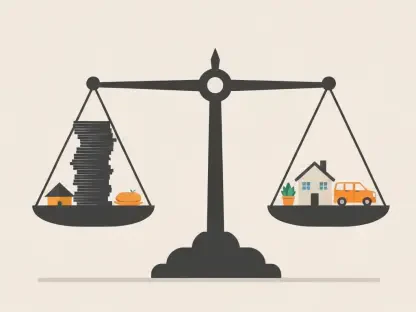A coalition of leading industrial real estate investment trusts (REITs) has announced an update to their methodology for calculating key non-GAAP property metrics. This move aims to improve consistency and comparability across the sector, benefiting investors, analysts, and other stakeholders. The Industrial REIT Group, comprising EastGroup Properties, First Industrial Realty Trust, Prologis, and STAG Industrial, is spearheading this initiative. By aligning on standardized methodologies, these REITs seek to enhance transparency and ease the process of comparing performance metrics within the sector.
The Need for Standardization
Inconsistent Metrics and Investor Confusion
Many industrial REITs have historically used varying methodologies to calculate non-GAAP property metrics. This inconsistency can make it difficult for investors to accurately compare the performance of different REITs, leading to potential misunderstandings and suboptimal investment decisions. Different calculation methods and terminologies employed by each REIT may result in varying interpretations of the same metric, adding to the confusion. Consequently, investors face challenges in benchmarking the financial health and operational efficiency of one industrial REIT against another, often struggling to make well-informed decisions.
The proliferation of bespoke metrics also complicates the work of analysts who rely on standard metrics for their comparative analyses. Without a uniform set of calculations, analysts have to adjust figures manually to draw meaningful comparisons, which can introduce errors or biases. This lack of standardization ultimately hampers the broader goal of transparency in the industrial real estate sector. By addressing these inconsistencies, the coalition’s initiative seeks to simplify and unify key non-GAAP property metrics, facilitating clearer and more accurate assessments across various REITs.
A Step Toward Uniformity
The coalition’s standardization of methodologies addresses these inconsistencies, bringing a uniform approach to key metrics. These metrics include annual same-store portfolios, which consist only of properties stabilized in both the current and prior periods, while excluding value-added and redevelopment properties. This uniformity streamlines the process of evaluating and comparing REITs for investors. Investors can now rely on a consistent framework, reducing the uncertainty and complexity previously associated with diverse metrics. It effectively lowers the barrier for comparative analysis, enabling easier decision-making and fostering more confidence in investment choices.
For REITs themselves, this harmonization underscores a commitment to clarity and reliability. By adopting a standardized methodology, REITs can present their performance metrics in a manner that is both understandable and comparable across the sector. This move is expected to play a significant role in aligning market perceptions and enhancing the evaluation process. Additionally, the consistent use of standardized metrics can contribute to more accurate forecasting and better alignment of investor expectations with actual operating performance. By taking this step towards uniformity, the Industrial REIT Group showcases its dedication to industry-wide best practices.
The Impact on Investors
Enhanced Comparability
With standardized metrics in place, investors can more accurately assess the performance of different REITs. This comparability fosters a better understanding of how each REIT operates and performs under similar criteria, leading to more informed investment decisions. Standardized metrics also level the playing field by removing the discrepancies introduced by varied reporting practices, giving all REITs an equal footing when demonstrating their financial health and operational capabilities. This level of transparency is particularly beneficial for institutional investors who depend on robust and consistent data for strategic investment.
Furthermore, the ability to compare REITs directly supports more rigorous portfolio diversification strategies. Investors can evaluate performance drivers, financial stability, and operational efficiencies across multiple REITs, enabling them to make well-rounded and diversified investment choices. The standardized metrics also aid in identifying sector trends, as investors can easily track performance patterns across different REITs and adjust their portfolios accordingly. Overall, the initiative amplifies clarity and enhances comparability, making it easier for investors to gauge their investment positions accurately.
Increased Transparency
The harmonization initiative emphasizes transparency, ensuring that investors have access to reliable and consistent information. By doing so, the REITs build trust and credibility, which are crucial for maintaining investor confidence. Transparent and standardized reporting practices diminish information asymmetry in the market, allowing investors to make decisions based on a clearer and more accurate depiction of each REIT’s true financial position. This transparency is instrumental in fostering long-term relationships between REITs and their investors, as it bolsters confidence in disclosed metrics and subsequent earnings reports.
Moreover, enhanced transparency aids in mitigating potential market volatility stemming from unforeseen financial disclosures. Regular and reliable updates, grounded in standardized methodologies, allow investors to anticipate performance trends more accurately and reduce the likelihood of reactionary trading. Trustworthiness in disclosed metrics also encourages more consistent and supportive coverage from market analysts, further contributing to market stability. The initiative’s emphasis on transparency ultimately lays the foundation for a more predictable and reliable investment environment within the industrial real estate sector.
The Coalition’s Strategic Goals
Long-term Benefits
The standardized methodologies are part of a broader strategy aimed at enhancing the reliability of reported metrics. For EastGroup Properties and its partners, this approach is expected to improve market perceptions and potentially attract more investors who value consistency and transparency. Enhanced reliability in reported data can help elevate these REITs’ market standings and lead to more favorable evaluations from rating agencies, translating into potentially lower borrowing costs and increased attraction of capital. Over time, the trust developed through consistent, transparent reporting can broaden the investor base and bolster market confidence.
Additionally, the long-term benefits extend to operational efficiencies. Standardized metrics streamline internal reporting processes, reducing the administrative burden associated with maintaining multiple reporting frameworks. This efficiency allows REITs to allocate more resources toward strategic initiatives and growth projects. Investors benefit from these strategic allocations as REITs can focus on enhancing property portfolios and optimizing operational performance. The initiative thus serves a dual purpose of reinforcing market perceptions while driving internal efficiencies that contribute to sustained investor value.
Commitment to Innovation
By leading this initiative, EastGroup and its coalition partners demonstrate their commitment to innovation and market leadership. This proactive stance signals to the market that they are dedicated to continuous improvement and excellence in the industrial real estate sector. The move to standardize metrics reflects a forward-thinking attitude and willingness to adopt best practices that can influence broader industry standards. It positions these REITs as innovators and thought leaders, potentially setting a precedent for the entire sector to follow.
Adopting standardized methodologies also prepares these REITs for future regulatory changes that may mandate uniform reporting practices. By voluntarily aligning with best practices, they not only establish themselves as industry leaders but also preemptively comply with potential regulatory requirements. This proactive approach minimizes disruption and positions them advantageously when industry-wide changes occur. It underscores a commitment to staying ahead of the curve and aligning with modern, transparent business practices that can shape the future landscape of the industrial real estate market.
Potential Challenges Ahead
Market Volatility and Economic Shifts
Despite the benefits, REITs must navigate various challenges, including changes in economic conditions, competitive environments, and potential market volatility. These factors can influence occupancy and rental rates, potentially affecting overall performance. External economic pressures, such as interest rate fluctuations, inflationary trends, and broader economic cycles, pose significant risks that can impact real estate valuations and investor returns. Competitive dynamics within the industrial real estate market, including new market entrants and shifts in tenant demand, also require REITs to continually adapt their strategies to maintain occupancy and rental income levels.
REITs need to be agile in adjusting to these fluctuating conditions to sustain their performance metrics. This may involve strategic asset management, rigorous lease negotiations, proactive tenant engagement, and timely portfolio adjustments. Additionally, effective risk management strategies, such as diversifying tenant bases and investing in high-demand locations, can mitigate some impacts of economic shifts. Investors must stay informed about these potential challenges and assess how each REIT navigates them to ensure ongoing stability and growth in their investments.
Regulatory and Environmental Risks
Legal and regulatory shifts, along with environmental concerns such as natural disasters and supply chain disruptions, present additional risks. Investors need to remain vigilant and consider these factors when evaluating forward-looking statements from REITs. Regulatory changes, including zoning laws, tax policies, and environmental regulations, can directly impact property valuations, development costs, and operational expenses. Environmental risks, such as flooding, earthquakes, or hurricanes, can cause significant physical damages and unforeseen financial liabilities, compelling REITs to invest in robust mitigation measures and insurance policies.
Supply chain disruptions pose further challenges, especially in construction and property development. Delays in material supplies or labor shortages can escalate costs and prolong project timelines, affecting REITs’ ability to deliver on planned developments and meet investor expectations. Effective contingency planning, robust risk management frameworks, and proactive engagement with regulatory bodies are essential to navigate these complexities. Investors should scrutinize these risk management strategies and evaluate REITs’ readiness to address potential disruptions when making informed investment choices.
Forward-looking Statements and Risks
Acknowledging Uncertainties
EastGroup and its partners have made several forward-looking statements about their plans and prospects. It’s essential for investors to understand the inherent uncertainties in these statements, as actual outcomes may differ due to various risk factors. The nature of forward-looking statements means they often rely on predictions and projections that are susceptible to change based on market conditions, economic trends, and unforeseen events. Investors should approach these statements with caution, recognizing the potential divergences between anticipated and actual results.
Forward-looking statements typically include language like “may,” “expects,” and “anticipates,” indicating their speculative nature. Investors should complement these projections with a thorough analysis of current market trends, historical performance, and broader economic factors to build a comprehensive understanding of potential risks and returns. Enhanced scrutiny and a cautious approach can help mitigate the uncertainties and drive more prudent investment decisions.
Mitigating Risks
EastGroup emphasizes the importance of managing risks associated with natural disasters, increased interest rates, and data security, among others. By addressing these potential challenges, the company aims to maintain its REIT qualification and operational resilience. Effective risk management strategies, such as diversifying portfolios geographically and across various tenant industries, can buffer against localized disruptions. Additionally, maintaining high-quality properties and investing in resilient infrastructure can help mitigate the impacts of natural disasters and safeguard asset values.
Interest rate management, through hedging and strategic financing, is crucial to control borrowing costs and preserve profitability. Data security measures are increasingly important in the digital age, given the growing threat landscape. Implementing robust cybersecurity protocols and continuously updating security measures can protect proprietary information and maintain investor confidence. By adopting comprehensive risk management frameworks, REITs can navigate uncertainties more effectively and sustain stable performance, aligning with investor expectations.
Reinforcing Market Leadership
Commitment to Excellence
EastGroup’s collaboration with other major REITs underscores its dedication to setting high standards in the industry. Their focus on operational excellence and market leadership positions them as a key player in the U.S. industrial properties sector. The coalition’s initiative to standardize metrics not only demonstrates a commitment to transparency but also signifies a broader dedication to enhancing industry practices. This leadership approach can inspire other REITs to adopt similar standards, driving overall sector improvements and benefiting the entire investment community.
Operational excellence, achieved through the integration of best practices and continuous improvement, is pivotal in maintaining a competitive edge. By focusing on high-quality properties in strategically important locations, EastGroup and its partners can continue to attract and retain top-tier tenants. The emphasis on innovation, along with operational rigor, signals to the market a robust and forward-looking business strategy that prioritizes long-term growth and stability, reinforcing their leadership status.
Engaging Stakeholders
A coalition of prominent industrial real estate investment trusts (REITs) has announced a significant update to their methodology for calculating essential non-GAAP property metrics. This new approach aims to foster greater consistency and comparability within the sector, which will ultimately benefit investors, analysts, and other stakeholders. Leading this initiative is the Industrial REIT Group, which includes EastGroup Properties, First Industrial Realty Trust, Prologis, and STAG Industrial. By adopting standardized methodologies, these REITs are committed to enhancing transparency and simplifying the process of comparing performance metrics throughout the sector. This update is expected to make it easier for market participants to evaluate and understand the true performance and value of industrial real estate investments. The coalition believes that these changes will lead to better decision-making, thereby improving the overall efficiency and effectiveness of the market.









